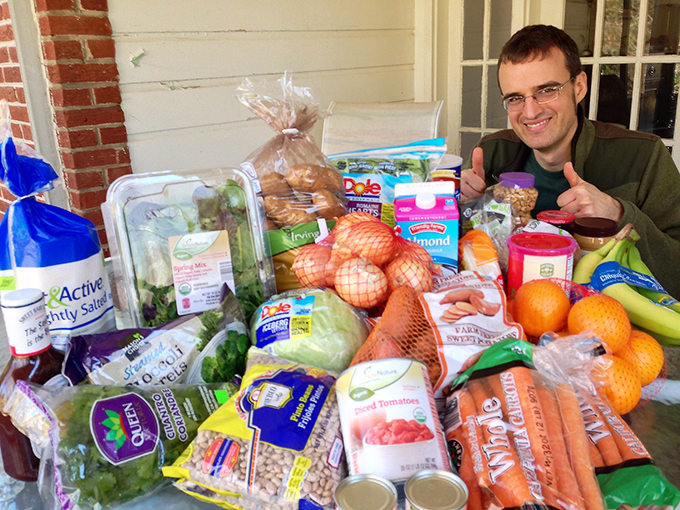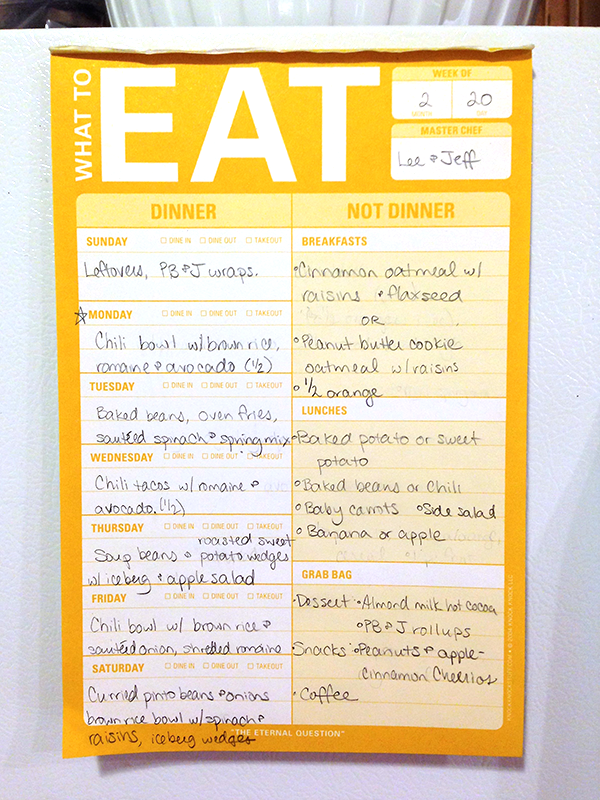
By shopping smart, we scored a whole week of eats (for an army, lol) for under $53. That’s what we normally pay for one bag of groceries at Whole Foods!
If Jeff and I were to get a grade on eating healthy on a budget, we’d get an F-.
Seriously.
To be fair, we do the healthy eating part fine. But when it comes to savings? Despite the fact that I’ve written entire posts on saving money at the supermarket, we don’t walk the talk. We still shop at Whole Paycheck Foods, buy loads of pre-fab foods like burritos and veggie burgers, and order in dinner at least twice a week.
But, back me up here—following a food budget is hard when you’re busy! Between working, commuting 2 hours round-trip for me and 3 hours for Jeff, and evening homework, we’re both exhausted when it’s time to fix dinner. Sometimes even ordering dinner feels like a chore. The thought of meal planning and cooking on top of everything else? Ain’t happening.
Instead, we’ve been spending on food like drunken sailors, then having a minor heart attack when the credit card bill comes in each month.
Until today, thanks to my dietetic internship.
SNAP challenge: Eating well on $4.13 a day
You see, the Academy of Nutrition and Dietetics wants every future dietitian to have a taste of what it’s like to try to buy food on a poverty budget. So in my program, for 1 week we each have to feed ourselves on the amount typically received by those who participate in the Supplemental Nutrition Assistance Program (SNAP).
To receive SNAP benefits, you have to make less than $15,444, or less than $31,596 for a family of four. After rent, utilities, childcare, transportation, and so forth, that means many families are buying food solely with SNAP dollars.
For our assignment, my fellow interns and I—along with Jeff, who agreed to join me on this “adventure,” which starts at lunch today—will be living on the average individual SNAP benefit of $28.93 per person, per week.
My first response upon seeing that number? Holy crap! $28.93 is the amount Jeff and I spend on lettuce in a week.
How on earth would we survive on $4 a day?
Clearly, we were going to starve.
Raising the bar: 5-9 servings of fruits & veggies, 20-minute meals

Okay, maybe we wouldn’t starve, but on our budget, buying produce and whole plant foods (except maybe beans) seemed out of the question. Yet we weren’t about to switch to an all-ramen diet—we’d go into veggie withdrawal. Somehow, we had to work in those veggies and fruits.
So after the initial shock (and a couple of days of freaking out), I decided it was game on, SNAP challenge. Not only would Jeff and I each eat for $4.13 a day, but we’d shoot for the moon: 5-9 servings of fruits and veggies a day and 100% plant based meals. Plus, since I figured we’d be just as busy this week as ever, I decided every meal had to be ready in 20 minutes or less.
Lucky for me, I love challenges like this—once I warm up to the idea, of course. The harder the better! After lots of brainstorming and research, here are the steps I devised for stripping our budget to bare bones while beefing up (beaning up?) our menu. Hopefully it gives you some ideas, too.
How to eat healthy for cheap: 7 steps, 1 meal plan, $4.13/person

Depending on how hard-core you want to be, you’ll need anywhere from 30 minutes – 2 hours to work through these steps. The payoff? Saving $50, $100, or more per month on food!
Yes, you can eat #healthy and #plantbased for $4/day! #SNAPchallenge http://bit.ly/2kYi6Sv Share on X1. List cheap & healthy foods you like. Ideas:
- Dried beans, split peas, lentils
- Sweet potatoes
- Regular potatoes
- Peanuts/peanut butter
- Affordable leafy greens (cabbage, romaine & iceberg lettuce, frozen spinach)
- Carrots
- Bananas
- Apples & oranges (in season)
- Corn tortillas
- Popcorn
- Brown rice
- Oatmeal
2. Brainstorm easy meals you can make with your fave cheap ingredients.
Think outside the box and use shortcuts. For example:
- Peanut butter + cooked oatmeal + sweetener = protein-packed, peanut butter cookie oatmeal
- Barbecue sauce + rinsed/drained pintos = baked beans
- Canned tomatoes + tomato paste + beans + chili powder/spices = veggie chili, which doubles as a taco filling, salad topper, and potato stuffer
For more ideas, check out Plant Based on a Budget or my $4.13/day meal plan for this week on my beloved What to EAT meal planning pad:

3. Include treats
Whether you have a sweet tooth or love savory snacks, make a little room in the budget for healthy(ish) treats. Because some days, you just need dessert. (I’m talking to you, Mondays!) For Jeff and me, I included either a cup of 42-calorie almond milk hot chocolate or a peanut butter and jelly roll-up every day. You might prefer a few squares of dark chocolate or a few dips of healthy chocolate frosting.
Because chocolate. 🙂
4. Make a shopping list
Based on the meals and treats you’ve chosen, make a shopping list for the week. If you aren’t doing a SNAP challenge, shop your own fridge, freezer, and pantry first. You’d be amazed at the good (and occasionally terrifying) stuff lurking in the back of your own fridge and cabinets.
5. Find target prices online
Once you have your shopping list, find prices online to give you targets to beat. I used an Walmart.com to price staples and my local grocery delivery service to price fresh items/produce. Having goal prices turns budget grocery shopping into a surprisingly fun, money-saving game.
6. Shop a discount supermarket first, then fill in gaps at your “regular” store
Specifically, SHOP AT ALDI.
No, really. Trader Joe’s, ethnic grocery stores, and wholesale clubs can have good deals, but Aldi is your best bet. I mean, we bought the huge pile of groceries in the pic up top for under $53. I confess, I got nervous that we might starve and overbought, which means we may actually have enough food for two weeks! Plus we’re going to hit our 5-9 servings of fruits & veggies a day without breaking a sweat.
After you’ve shopped the discount store, fill in with items from your “regular” grocery store, whether that’s Wal-Mart or Whole Foods.
7. Put your plan into action
Now comes the fun, if slightly scary part: eat your fun new food! For me, that’ll mean a little investment cooking today: baking potatoes and and cooking dried beans in the instant pot. (Total hands-on time: 20 minutes, plus 1-2 hours in the oven for the potatoes.) Then every meal for the rest of the week should take under 20 minutes.
So, how will it go? Great question! 😉 Follow me on Instagram, Twitter, and Facebook to track my progress and let me know what you think.
Wish me (and Jeff) luck as we embark on our journey to eat healthy and plant-based for $4.13 a day!
UPDATE: See how we did in the recap post here! (Spoiler alert: There *may* have been a cheat…)
Your turn:
How do you like to save money on groceries?




 I'm Lee, an RD thriving on a healthy plant based diet.
I'm Lee, an RD thriving on a healthy plant based diet.
We (hubby and I) save grocery money two ways: 1) we shop by a written menu and shopping list; and 2) we hit the stores (including ALDI and 7 others) only AFTER first determining online which ones have precisely what we need that week.
We do order some of our groceries from online sources (e.g., nonperishables and bulk dry goods), but our primary money-savers are that written menu and list. NEED vs. WANT: if it’s not on the list, take a quick pic of its label and ingredient list, and keep on truckin’ 🙂
Since coupons (e- and paper ones) are almost always for branded, highly-processed “foods” that we don’t consume, the only other thrift I’d like to explore is THRIVE Market and its purported competitiveness. Lee, anyone, can you (may you?) answer a few questions about THRIVE’s pricing and availability?
Ooh, Mae, those are some great tips! I love the idea of scoping out prices online before you go to the store–I’m going to start doing that! Of course, the trick will be to stick to our list, which Jeff is pretty good at, but alas, I am not. I think having a concrete budget beforehand will help, although I can guarantee you it’ll be more than $4/day!
Honestly, I’d never heard of THRIVE until your comment. Thanks for the heads up! I just signed up for a (free) account. I’ll explore the site and report back!
Mae, if you’re still reading: I tried THRIVE on a special offer trial membership. I bought a few interesting things that my local stores don’t have, and customer service was fine and everything. But their prices on most things were no better than my local stores. I think it would be most useful to people who live in places with fewer shopping options and/or stores that carry less of a selection of healthy foods. (I’m in Pittsburgh and am a member of a health food co-op and Costco, as well as living within a few miles of Aldi and Trader Joe’s and within walking distance of ethnic markets and a supermarket that carries a lot of good stuff and gives me coupons for produce, whole wheat flour, frozen vegetables, and other basics I actually buy.)
Thank you, Becca, for your info on THRIVE Market and what it really has to offer potential members. Because we live in a suburb of Atlanta, Georgia (hence, the “OTP in the ATL”)—with its sizeable variety of both food distributors AND growers—I suspected THRIVE Market was not quite the right fit for us 🙂 We’ll just have to continue cutting our grocery expenses down by further streamlining and seasonally parsing our menus.
–Mae
Hi Becca, thanks for the feedback on THRIVE! I’ve been meaning to try it, but since I too have access to Aldi and Trader Joe’s and ethnic markets, maybe I’ll hold off.
Hi Lee! Good luck with your challenge! I always like reading posts and challenges like this because it gets me into review mode. My monthly income actually puts me within these income guidelines, though my savings and retirement would dsqualify me from assistance. Nevertheless I eat within my monthly budget each month. But not having to make a house payment helps a lot. I find it’s hard to achieve a figure this low because in the end I want to get organic as much as possible, and I eat a much higher quotient of greens and cruciferous, which end of being expensive. Still, I try to shop at Fred Meyer, maybe you equivalent of Aldi??, and they have a line of Simple Truth Organics that’s affordable in terms of canned beans, dried grains and beans, etc. Also a bulk section. But in the end, the organic greens, the nondairy milk and even gluten free oats bought by the 25 pound bag from Bob’s Red MIll add up to more than this. I do it because I can, and because I feel better as a result, and food IS my medicine. . .I am right on board with the simple 20 minute meal thing though. . .I just bake and mix and match like you suggest. . .I don’t have an instant pot and do fine. . .but for now I’m keeping my hemp milk and organic greens and pitted dates for treats. Tahini’s way better for me than peanut butter, but more expensive. . .and then there’s always the fact that I get just one ride to the store and also need to get those other things like TP and mouthwash and so forth that push up the price tag. . .but I’ll keep aspiring. . .and I agree it can be done without Whole Foods for the most part. . .always a work in progress. . .look forward to reading how it goes for you and Jeff!! xoxo
Hi Maria, congrats on sticking to a food budget. That takes discipline and planning, which have been in short supply for most of my life, but especially during internship. 😉 Boy, was the SNAP challenge a wake-up call, though! I’ll save the full story for my next post. (Which will be a little late cause I caught the freakin’ FLU at the end of SNAP week; that’ll teach me to cut down on greens…)
Needless to say, despite doing decently well health-wise, Jeff and I couldn’t eat the quality, types, or variety of foods that we wanted/needed to on a SNAP budget. So we’re back to 4-5 tubs of organic mixed greens a week, but we’re also a little more savvy about the rest of our purchases. But I totally agree with you — food is medicine! Even at the beginning of the week when I was still healthy, I noticed my energy and mood drop within 24 hours of cutting back on fruits on veggies. (Down to “just” 5 a day. 😉 ) Since I’m able to do it, I too will keep investing in my health via high-quality food!
Hi Lee, I love your post and agree with you that it’s exciting to have a challenge like this. That being said, I would also advocate for each of us being honest with ourselves about where healthy food fits into our overall budget. No matter what our income, each of us makes choices about our priorities. Of course there are basic necessities like rent, but there are other areas that might be considered necessities by some but choices by others, particularly in the areas of electronics, internet services, or fashion. What we eat can be very cheap in order to have more money for the latest cell phone or designer sneakers. Or we can spend more at the grocery store and put more time into cooking at home, and spend less money on our gadgets and less time on social media. I guess that sounds judgmental, but this is a public health crisis that requires education about all these choices.
Hi Gwenyth, I agree, we all have a responsibility to prioritize healthy food in our budgets! No matter our income level, we should buy the best quality foods we can afford. Of course, it’s frustrating to realize that some who make very little choose to spend it on fancy cell phone plans instead of good food. However, I’m thinking there are as many or more low-income single moms out there spending responsibly who still have to rely mostly or entirely on SNAP benefits to feed their kids. I also agree that schools spend precious little time educating kids about nutrition and the impact it has on their bodies.
“If Jeff and I were to get a grade on eating healthy on a budget, we’d get an F-.”
Oh ditto my friend. One of my goals this year is to be more budget conscious. So far it hasn’t gone well, but I am regrouping.
“shop your own fridge, freezer, and pantry first.” Oh my gosh yes. Would you believe I was wandering the aisles of Whole Foods a couple of weeks ago and came across coconut butter and thought I had set aside a recipe to try with it and bought it only to come home and find an opened jar already in my cupboard AND I can’t find the recipe I set aside? For seriously. I was getting in really good habits last year about menu planning for the week and that really helped with the budget. And there is a store down the road that is cheaper than Whole Foods. It doesn’t carry everything, but just about! I just find I don’t have time to make trips to more than one store, so I just go to Whole Foods as I know I’ll find everything. Not a great excuse. I need to find time. We’re working with one income right now and if you can find time, I can find time! This is really inspiring =)
Ahhh haha that is SO me! Buying the ingredient I didn’t realize I already had because I want to try a recipe. Then not being able to find the freakin’ recipe…oh yes…😂 Bummer that it happened with coconut butter, though, that stuff is expensive for real!
I know, Jeff and I usually fall into the Whole-Foods-for-Convenience trap. I think we’re going to try to start hitting Aldi once every week or two, then fill in with the organics and specialty stuff at Whole Foods. We’ll see how long that lasts…more in the wrap-up post I’m supposed to be working on right now. 😉 Let me know how it goes getting back on budget!
This is such a geat post. I love that you show you can actually eat a healthy plant-based diet on a budget. Many people say that a vegan diet is too expensive and as you prove, that’s just not true. Sure, if you’re getting ice cream, special faux meats and cheese etc, it could be difficult but beans and vegggies can be relatively cheap.
Thanks so much for all of this information. I think it’s so important to know that there are many families living in this kind of poverty. I know personally I probably spend too much on food so I’m going to take a look at our household’s budget more now.
You’re doing such a great job!
Aw, thanks Mary Ellen! Now that our SNAP budget week is over, we’re obviously spending more than $4/day. But we’ve cut our budget by about $50/week and we’re still buying lots of organics, so I’m pretty happy. Overall, since we’re cooking more and wasting less, we’re eating healthier, too. In a weird way, it’s kind of become a game to find new ways to save. Gotta get your fun where you can, right? 😉
Great post! It just proves that you don’t have to break the bank to eat healthy. Thanks for sharing!
You bet, thanks Candace!
Lee, I have to ask why you have such long commutes–why do you live so far from work and school? I know there could be a very good reason, but I wonder because the cost of gas for a long commute by car is another factor that can stop people from being able to afford healthy food. Where I live, poorer people tend to use public transit rather than own cars; they may spend more time waiting and riding than they would driving, but the cost of monthly transit passes is lower than the cost of gas, car insurance and maintenance, and parking. My parents live in a less densely populated area where public transit is very limited, and the cost of gas is a HUGE issue for poorer people there. What makes me sad is that as they’re struggling to pay for transportation between the jobs they can find and the places they can afford to live, they’re spending a huge chunk of their hard-earned money on irreplaceable fossil fuel that they’re simply burning up into the air–making themselves and everyone else even less healthy! But the majority of the United States is set up in ways that make long drives necessary, so not everyone has a meaningful choice about how far to travel or how to get there. 🙁
Hi Becca, good question! Jeff used to work close to home, but an excellent job opportunity arose farther from home, and he took it. Ironically, it’s not actually that far away geographically, but it’s not accessible via public transport and with traffic in DC he easily spends 2.5-3 hours a day commuting.
And in my dietetic internship (a 9-month, full-time credentialing program for dietitians), I was assigned rotation sites, which changed every month or so. Some were close to home, some weren’t! In fact, the 2-hour round trip commute I had at the time I did the SNAP challenge was actually via walking and public transport because it took the same amount of time and was cheaper. I agree–transportation costs eat up an enormous proportion of the budget of folks on a low income, especially in rural areas where it sounds like your parents live. As for global warming, I like to think that eating plant-based offsets at least some of the carbon emissions from Jeff’s long commute. Of course, once the dust settles and I settle into a job, we may opt for a move.